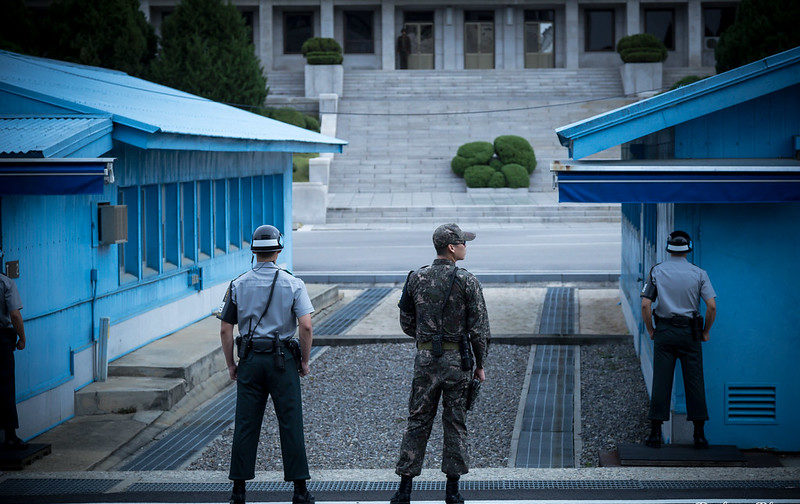 ROK soldiers facing N. Korea across the DMZ (Image credit: Dickson Phau)
ROK soldiers facing N. Korea across the DMZ (Image credit: Dickson Phau)
Arms Control Agreement with North Korea Could be the Path Forward
In the wake of recent reports suggesting ongoing plutonium production in North Korea, President Biden must decide what his strategy in North Korea will be. Imposing harsh sanctions and moving through a revolving door of negotiations have been the trademark of U.S. foreign policy towards North Korea for the past several administrations. Despite these efforts, the size of the North Korean nuclear program has continued to increase and there is little sign of a reversal. The Biden administration has the option to continue the decades old strategy of tough-talk, or it can accept reality and heed the calls for a new approach.
Why is North Korea Obsessed with Nuclear Weapons?
North Korea has been a thorn in the side of the U.S. government and the international community ever since the beginning of the Korean War in 1950. Since the armistice in 1953, North Korea is a fitting example of what some scholars refer to as a “security seeking” state, that is, a country whose behavior is motivated solely by an interest in self-preservation and not by a desire for expansion. In this way, nuclear weapons are a guarantor of North Korea’s security. The nuclear tests and ballistic missile launches have mostly served as genuine testing of North Korea’s technology, while providing a display of its deterrent.
Currently, estimates of the North Korean arsenal place the number of warheads between 20 and 60, and it is likely that they have the ballistic missile capability to launch some of those warheads into the United States. However, it is important to remember, terrifying as it may be, that the true purpose of the warheads is not to lob them indiscriminately towards our shores. Rather, North Korea is building a deterrent against those countries it sees as a threat to its existence; namely, the United States. As North Korea would be unable to defeat the United States militarily, nuclear weapons provide the Kim regime with a means of significantly raising the cost on an attempted invasion of the North. It is the regime’s hope that this projected cost would sufficiently deter the United States, or even South Korea, from deciding to attack or invade.
North Korea has been very vocal about its insecurity regarding the motivations of the United States. In the 1994 Agreed Framework – the only bilateral agreement between the U.S. and North Korea which effectively broke down by 2003 – assurances against the threat or use of U.S. nuclear weapons were explicitly included. Nevertheless, North Korea was undeterred and while the agreement was still standing, North Korea continued a secret uranium enrichment program. After several administrations’ worth of strategizing on the Korean Peninsula, all signs point to the fact that North Korea will not, under any circumstances, relinquish its nuclear weapons. But this does not mean that the North Korean issue is doomed to plague the world for years to come.
Where Should We Go from Here?
There is certainly no shortage of discussion on how to best deal with North Korea, but serious experts on the subject agree that demanding a “complete, verifiable, and irreversible denuclearization” (CVID) of the Korean Peninsula is not the way to go about it. Instead of attempting to defy the odds by insisting on CVID, a more realistic approach would be to push for a bilateral arms control agreement to limit the North Korean arsenal from becoming completely intractable.
The primary U.S. obligation in an arms control agreement would undoubtedly be limitations of conventional military forces in the region. Since there has never been a formal peace treaty to end the Korean War, the formation of one could begin constructive discourse and offer assurance to the North Koreans. In attempting to reach an agreement, cooperation and consultation with South Korea and Japan cannot be ignored, as they are major U.S. allies with stake in the game. South Korean President Moon Jae-in has been working cooperatively with Kim Jong Un recently and could help to facilitate a deal.
North Korea must commit to limitations on both its arsenal and the amount of fissile material in its possession; complete with verification from the IAEA. Transparency will be key to preventing another break down of relations due to skepticism regarding compliance. The Biden administration must soon decide how they will approach the decades old issue that has plagued the international nuclear community. He can either continue to demand the unrealistic at the expense of national security, or take a fresh attitude in the hopes of lasting stability.
Image license: Creative Commons — Attribution-NonCommercial-NoDerivs 2.0 Generic — CC BY-NC-ND 2.0





